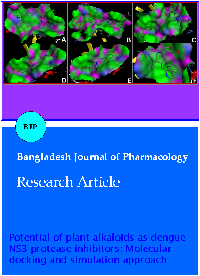Potential of plant alkaloids as dengue NS3 protease inhibitors: Molecular docking and simulation approach
DOI:
https://doi.org/10.3329/bjp.v9i3.18555Keywords:
Alkaloid, Dengue virus inhibitor, DENV-NS2B/NS3 protease inhibitor, Molecular docking, PhytochemicalAbstract
Dengue infection has become a worldwide health problem and infection rate is increasing each year. Alkaloids are important phytochemicals of medicinal plant and can be used as vaccine candidates for viruses. Therefore, present study was designed to find potential alkaloids inhibitors against the Dengue virus NS2B/NS3 protease which can inhibit the viral replication inside the host cell. Through molecular docking it was investigated that most of the alkaloids bound deeply in the binding pocket of Dengue virus NS2B/NS3 protease and had potential interactions with catalytic triad. Five alkaloids (6-desmethylthalifaboramin; 3,5-dihydroxythalifaboramine; Betanin; Reserpic acid and Tubulosine) successfully blocked the catalytic triad of NS2B/NS3 protease and these alkaloids can serve as a potential drug candidate to stop viral replication. It can be concluded from this study that these alkaloids could serve as important inhibitors to inhibit the replication of DENV and need further in-vitro investigations to confirm their efficacy and drug ability.
Downloads
2947
1412 Read
622
References
Ashfaq UA, Mumtaz A, ul Qamar MT, Fatima T. MAPS Database: Medicinal plant activities, phytochemical and structural database. Bioinformation 2013; 9: 993-95.
Calixto JB. Efficacy, safety, quality control, marketing and regulatory guidelines for herbal medicines (phytotherapeutic agents). Braz J Med Biol Res. 2000; 33: 179-89.
Chambers TJ, Hahn CS, Galler R, Rice CM. Flavivirus genome organization, expression, and replication. Annu Rev Microbiol. 1990; 44: 649-88.
Das S, Pingle MR, Munoz-Jordan J, Rundell MS, Rondini S, Granger K, Chang GJJ, Kelly E, Spier EG, Larone D, Spitzer E, Barany F, Golightly LM. Detection and serotyping of dengue virus in serum samples by multiplex reverse transcriptase PCR-ligase detection reaction assay. J Clin Microbiol. 2008; 46: 3276-84.
Hakim ST, Tayyab SMH, Nadeem SG. An experience with dengue in Pakistan: An expanding problem. Ibnosina J Med BS. 2011; 3: 3-8.
Idrees S, Ashfaq UA, Khaliq S. RNAi: Antiviral therapy against dengue virus. Asian Pac J Trop Biomed. 2013; 3: 232-36.
Idrees S, Ashfaq UA. A brief review on dengue molecular virology, diagnosis, treatment aAnd prevalence in Pakistan. Genet Vaccines Ther. 2012; 10: 6.
Irwin JJ, Sterling T, Mysinger MM, Bolstad ES, Coleman RG. ZINC: A free tool to discover chemistry for biology. J Chem Inf Model. 2005; 45: 177-82.
Jassim SA, Naji MA. Novel antiviral agents: A medicinal plant perspective. J Appl Microbiol. 2003; 95: 412-27.
Kubmarawa D, Khan ME, Punah AM, Hassan. Phytochemical screening and antibacterial activity of extracts from Parkia clappertoniana keay against human pathogenic bacteria. J Med Plants Res. 2008; 2: 352-55.
Khan AM, Miotto O, Nascimento EJ, Srinivasan KN, Heiny AT, Zhang GL, Marques AT, Tan TW, Brusic V, Salmon J, August JT. Conservation and variability of dengue virus proteins: Implications for vaccine design. PLoS Negl Trop Dis. 2008; 2: 272.
Lengauer T, Rarey M. Computational methods for biomolecular docking. Curr Opin Struct Biol. 1996; 6: 402-06.
Li J, Lim SP, Beer D, Patel V, Wen D, Tumanut C, Tully DC, Williams JA, Jiricek J, Priestle JP, Harris JL, Vasudevan SG. Functional profiling of recombinant NS3 proteases from all four serotypes of dengue virus using tetrapeptide and octapeptide substrate libraries. J Biol Chem. 2005; 280: 28766-74.
Lipinski CA, Lombardo F, Dominy BW, Feeney PJ. Experimental and computational approaches to estimate solubility and permeability in drug discovery and development settings. Adv Drug Deliv Rev. 1997; 46: 3-26.
MOE: Molecular Operating Environment (MOE). Chemical Computing Group Inc, 1010 Sherbooke St West, Suite #910, Montreal, QC, Canada, H3A 2R7 2012.
Murthy HM, Clum S, Padmanabhan R. Dengue virus NS3 serine protease: Crystal structure and insights into interaction of the active site with substrates by molecular modeling and structural analysis of mutational effects. J Biol Chem. 1999; 274: 5573-80.
Rothan HA, Han HC, Ramasamy TS, Othman S, Rahman NA, Yusof R. Inhibition of dengue NS2B-NS3 protease and viral replication in Vero cells by recombinant retrocyclin-1. BMC Infect Dis. 2012; 12: 314.
Thomas SJ, Strickman D, Vaughn DW. Dengue epidemiology: Virus epidemiology, ecology, and emergence. Adv Virus Res. 2003; 61: 235-89.
ul Qamar MT, Mumtaz A, Ashfaq UA, Azhar S, Fatima T, Hassan M, Hussain SS, Akram W, Idrees S. Computer aided screening of phytochemicals from Garcinia against the Dengue NS2B/NS3 Protease. Bioinformation 2014; 10: 115-18.
van Hell AJ, Crommelin DJ, Hennink WE, Mastrobattista E. Stabilization of peptide vesicles by introducing interpeptide disulfide bonds. Pharm Res. 2009; 26: 2186-93.
Watson AA, Fleet GW, Asano N, Molyneux RJ, Nash RJ. Polyhydroxylated alkaloids Ð natural occurrence and therapeutic applications. Phytochemistry 2001; 56: 265-95.
Weaver SC, Vasilakis N. Molecular evolution of dengue viruses: Contributions of phylogenetics to understanding the history and epidemiology of the preeminent arboviral disease. Infect Genet Evol. 2009; 9: 523-40.

Published
How to Cite
Issue
Section
License
Authors who publish with this journal agree to the following terms:
- Authors retain copyright and grant the journal right of first publication with the work simultaneously licensed under a Creative Commons Attribution License that allows others to share the work with an acknowledgement of the work's authorship and initial publication in this journal.
- Authors are able to enter into separate, additional contractual arrangements for the non-exclusive distribution of the journal's published version of the work (e.g., post it to an institutional repository or publish it in a book), with an acknowledgement of its initial publication in this journal.
- Authors are permitted and encouraged to post their work online (e.g., in institutional repositories or on their website) prior to and during the submission process, as it can lead to productive exchanges, as well as earlier and greater citation of published work (See The Effect of Open Access).
